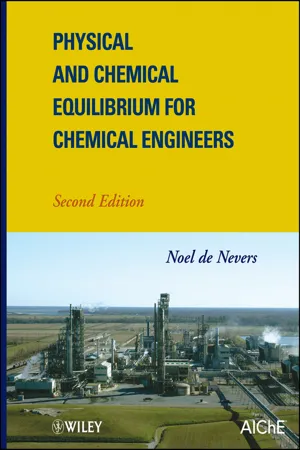
- English
- ePUB (mobile friendly)
- Available on iOS & Android
Physical and Chemical Equilibrium for Chemical Engineers
About This Book
This book concentrates on the topic of physical and chemical equilibrium. Using the simplest mathematics along with numerous numerical examples it accurately and rigorously covers physical and chemical equilibrium in depth and detail. It continues to cover the topics found in the first edition however numerous updates have been made including: Changes in naming and notation (the first edition used the traditional names for the Gibbs Free Energy and for Partial Molal Properties, this edition uses the more popular Gibbs Energy and Partial Molar Properties, ) changes in symbols (the first edition used the Lewis-Randal fugacity rule and the popular symbol for the same quantity, this edition only uses the popular notation, ) and new problems have been added to the text. Finally the second edition includes an appendix about the Bridgman table and its use.
Frequently asked questions
Information
Table of contents
- Cover
- Series Page
- Title Page
- Copyright
- Preface
- About the Author
- Nomenclature
- Chapter 1: Introduction to Equilibrium
- Chapter 2: Basic Thermodynamics
- Chapter 3: The Simplest Phase Equilibrium Examples and Some Simple Estimating Rules
- Chapter 4: Minimization of Gibbs Energy
- Chapter 5: Vapor Pressure, the Clapeyron Equation, and Single Pure Chemical Species Phase Equilibrium
- Chapter 6: Partial Molar Properties
- Chapter 7: Fugacity, Ideal Solutions, Activity, Activity Coefficient
- Chapter 8: Vapor–Liquid Equilibrium (VLE) at Low Pressures
- Chapter 9: Correlating and Predicting Nonideal VLE
- Chapter 10: Vapor–Liquid Equilibrium (VLE) at High Pressures
- Chapter 11: Liquid–Liquid, Liquid–Solid, and Gas–Solid Equilibrium
- Chapter 12: Chemical Equilibrium
- Chapter 13: Equilibrium in Complex Chemical Reactions
- Chapter 14: Equilibrium with Gravity or Centrifugal Force, Osmotic Equilibrium, Equilibrium with Surface Tension
- Chapter 15: The Phase Rule
- Chapter 16: Equilibrium in Biochemical Reactions
- Appendix A: Useful Tables and Charts
- Appendix B: Equilibrium with other Restraints, Other Approaches to Equilibrium
- Appendix C: The Mathematics of Fugacity, Ideal Solutions, Activity and Activity Coefficients
- Appendix D: Equations of State for Liquids and Solids Well Below their Critical Temperatures
- Appendix E: Gibbs Energy of Formation Values
- Appendix F: Calculation of Fugacities from Pressure-Explicit EOSs
- Appendix G: Thermodynamic Property Derivatives and the Bridgman Table
- Appendix H: Answers to Selected Problems
- Index
- Common Units and Values for Problems and Examples